Nelson’s Pillar
Published in 18th–19th - Century History, 20th-century / Contemporary History, Features, Issue 4 (Winter 1998), Volume 6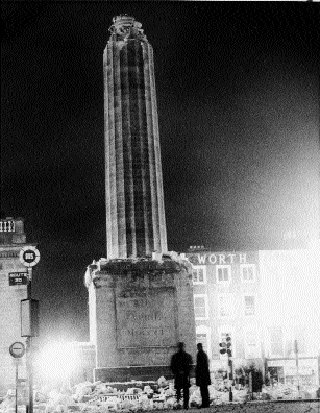
Dublin continues to debate a replacement for Nelson’s Pillar, but in its own time (1808-1966), while lording it over Dublin’s O’Connell Street, the Pillar was debated again and again in parliaments, newspapers and council chambers. A controversy that would have continued into the indefinite future was suddenly jolted on Tuesday morning, 3 March 1966. Under an eight-column headline—EXPLOSION WRECKS THE PILLAR—the Irish Times reported that:
The top of Nelson Pillar, in O’Connell Street, Dublin was blown off by a tremendous explosion at 1.32 o’clock this morning and the Nelson statue and tons of rubble poured down into the roadway.
Minister for Justice Brian Lenihan TD condemned the ‘reckless action…an outrage which was planned and committed without any regard to the lives of the citizens’. He expressed relief that no loss of life or injuries had occurred. A dance was ending in the Metropole Ballroom, (where Penney’s is today) when the explosion took place.
The question was what to do with the seventy foot ‘stump’, (the truncated column and pedestal). With almost indecent haste government announced that the entire structure was to be removed. Several representations were made to the Taoiseach’s office that the Pillar be rebuilt and capped with a statue of someone other than Nelson but files in the National Archives show zero support for that notion. Earlier documents reveal that Sean Lemass regarded the Pillar as an embarrassment. One can surmise that its destruction, on the eve of the fiftieth anniversary of the 1916 Rising, was regarded as a bonus. His inclination was to finish the job.
Much loved by Joyce, Yeats and Gogarty
Thomas McGreevey, then recently retired Director of the National Gallery, was one of those who wrote to the Taoiseach about the fate of the truncated column, which he described as ‘the finest Doric pillar, as far as I know, in Britain or Ireland’. A telegram from the Irish Literary Association pleaded ‘for preservation of lettering on pedestal of pillar, so much loved by Joyce, Yeats and Gogarty’. Máire Bhreathnach, an assistant secretary in the Department of Finance, wrote to the Taoiseach’s secretary, praising the beauty of the Pillar ‘especially against a winter sky’. She would like to have Wolfe Tone on a rebuilt pillar but fearing that Tone would be ‘too controversial’ she suggested Robert Emmet instead. A resident of Ealing and another from Portadown suggested a monument to Michael Collins in place of the Pillar. A monument to Pearse was suggested by a writer from Thurles. Two letters from the US expressed ‘delight’ at the blowing up of Nelson, while a ‘Presbyterian’ from Derry and an émigré in London respectively expressed outrage and shame at the uncivilised act.
A letter in the Evening Herald declared that ‘the stump stands not as a monument to Kevin Barry…it represents the bravery of pygmies who against impossible odds dared to bring to dust a formidable enemy who has been dead these many years’. A less choleric observer in the Irish Times approvingly noted ‘the novelty of a cleared O’Connell Street and a newly revealed GPO’. The same paper reported that the Royal Irish Academy of Music was thinking of taking legal action to prevent the removal of the stump.
In any event the Corporation issued a ‘dangerous building notice’ and the trustees agreed to the total removal of the Pillar’s stump, provided they were indemnified against any possible legal action. On 9 March, six days after the explosion, Colonel R.G. Mew, Army Director of Engineering, completed a report on the implications of ‘felling’ the stump by explosives. He recommended making ‘eccentrically placed bore holes around the base forming what might be called a “wedge”’. Colonel Mew warned that there would be ‘damage to adjoining property…greater than the original damage since the charges will be nearer the ground’. Sandbags could be used to mitigate the damage, but ‘no matter what happens the public will make invidious comparisons [between] our work and the previous effort’.
‘True for him’ as the saying goes. When the army did its work on 11 March, it was accused of clumsiness in contrast to the skill shown by the original bombers. In fact, the eventual public liability claims totalling £43,000 showed only slightly more claims from the second explosion than from the first.
With the job completed and the street cleaned up, Sean Lemass wrote personal letters to Minister for Defence Michael Hilliard TD, and to Minister for Local Government Neil Blaney TD, asking them to convey his appreciation to the Army and to the Dublin Corporation staff ‘who had so expeditiously completed the removal of the Pillar’. The St Patrick’s day parade and the Easter Rising jubilee celebrations took place with no Horatio Lord Nelson, Duke of Bronti, viewing them with a jaundiced eye from his column aloft. Various reports appeared of Nelson’s head turning up in an antique shop in Soho but eventually it returned to Dublin, where it is now on permanent display in the Civic Museum, South William Street.
Fringe republicans blamed
On the day of the first explosion the Irish Times reported the ‘official view’ that the explosion was carried out by a ‘fringe group of republican militants…There is no evidence that the small and impermanent group intend to carry out further stunts…it is possible that the group was got together simply to demolish the Pillar’. Two days later the Irish Republican Publicity Bureau announced that ‘the republican movement’ was in no way involved with the explosion, and…such actions were ‘contrary to the policy’ of the movement. It was reported that various houses were visited and persons questioned by the Gardaí but no one was charged as a result.
The formal laying of the foundation stone of the Pillar on 21 October 1809, the fourth anniversary of the Battle of Trafalgar and of Lord Nelson’s death, contrasted sharply with its dismal denouement. The Lord Lieutenant, Duke of Richmond, led by a procession of horse and foot yeomanry, by the Provost and Fellows of Trinity College and ‘peers according to their degrees’, sailors, officers of army and navy, sheriffs, aldermen and so on, performed the task. Eighteen months later, the Pillar was opened to the public at a fee of 10d per person, later reduced to 6d, for the privilege of climbing the 168 steps to stand dizzily on the Doric abacus (111 feet above street level) for a panoramic view of the city, bounded by the bay to the east, the Wicklow mountains to the south, and, on a clear day, by the Mourne mountains to the north.
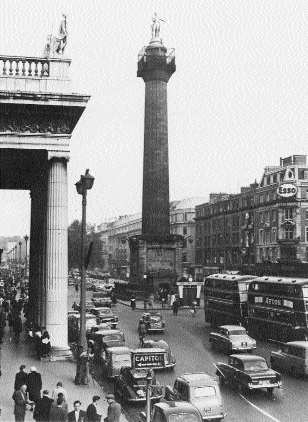
Why a pillar in Dublin?
Why was Dublin was so quick off the mark in erecting such a memorial to Nelson, ten years before the completion of a similar memorial in Great Yarmouth and thirty-two years before London’s monument in Trafalgar Square. Dublin was the second city in the British Empire and its ‘nobility, clergy, bankers, merchants and citizens’ would have been concerned to underline their loyalty to that Empire. Their sense of obligation to Nelson for the defeat of the French navy and the re-opening of the sea-lanes to merchant shipping would have been all the greater because of their recall of French invasions, in 1796 and 1798. Indeed when news of the victory at Cape Trafalgar on 21 October 1805, arrived in Dublin, via London, on 8 November ‘scenes of jubilation that at times led to riot and disorder’ ensued. Nelson’s death in the hour of victory didn’t seem to have dampened the jubilation.
Ten days later, on 18 November, Dublin’s aldermen despatched their congratulations to George III on the victory and agreed ‘on the expediency of some speedy and practicable measure to compliment the memory of Lord Nelson’. With impressive speed a public meeting in the Royal Exchange at 1pm, on Saturday 23 November, passed a series of resolutions launching an appeal and appointing a twenty-one-man committee to manage the project. Arthur Guinness was one of them.
Controversy surrounded the siting of the Pillar. The Wide Streets Commissioners disapproved of the Sackville Street proposal and argued that the Pillar should be located nearer the river, where it would be better seen by sailors approaching the port. Some suspected that the real issue was not one of respect for Nelson but a fear that the relative quietness of their street would be disturbed by crowds attracted to the new monument.
The Lord Lieutenant is reputed to have ended the debate in favour of the central site in Sackville Street. Armagh-born Francis Johnston was consulting architect but there is some uncertainty as to the extent to which he adhered to a preliminary design by William Wilkins of Caius College, Cambridge. At any rate, Johnston, one of the trio responsible for the Bank of Ireland in College Green as it is today, was certainly responsible for the GPO (1814-1818). So, one can say that the GPO’s facade, neighbouring the Pillar, was designed by hands which were involved in both structures.
‘Records the glory of a mistress’
The completed work, including the statue, railings, lamps and ‘other expenses’ came to £6,856-8s-3d leaving a surplus of £281-18s-11d. The appeal announcements boasted of subscriptions from people ‘of all ranks’, but 90 per cent of the subscriptions came from 230 named persons. Immediate newspaper comment on the completion of the Pillar was favourable but in September 1809 the Irish Magazine, published by the ‘rascally Watty Cox’ (Roy Foster’s description), took a very different line in reference to the ‘topping-out’ ceremony:
We never remember an exhibition that was marked with more indifference on the part of the Irish public, or at least that part who pay the taxes and enjoy none of the plunder.
Cox’s comments concluded with slightly oblique references to the Act of Union, to Nelson’s extra marital affairs and to the purchase of the old Parliament by the Bank of Ireland:
our independence has been wrested from us, not by the arms of France but by the gold of England. The statue of Nelson records the glory of a mistress and the transformation of our senate into a discount office.
Not much later, trenchant criticism of the ‘aesthetics rather than the politics’ of the Pillar appeared in A History of the City of Dublin (Warburton, Whitelaw and Walsh) published in 1818:
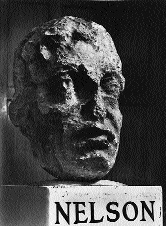
Nelson’s head, now in the Dublin Civic Museum. (Mark Fiennes)
Its vast unsightly pedestal is nothing better than a quarry of cut stone, and the clumsy column is divested of either base or what could properly be called a capital. Yet with all this baldness and deformity, it might have had a good effect when viewed at a distance, or placed anywhere else; but it not only obtrudes its blemishes on every passenger, but actually spoils and blocks up our finest street, and literally darkens the two other streets opposite to it.
Similar early criticism of the siting of the Pillar ‘by several English visitors’ (c. 1825) is recorded by Constantia Maxwell in Dublin under the Georges. Illuminated with electric light it was one of the showpieces for Queen Victoria’s oddly-timed but successful visit to Dublin in 1849 while cholera still stalked the streets. Such was the pride many felt for the monument that it would come be known as ‘Dublin’s Glory’.
Location a constant cause of dispute
A plan for Dublin, displayed in the Great Exhibition of 1853, provided for removal of the Pillar and The Irish Builder thought that its removal was the only sensible aspect of that plan. In 1876 Dublin Corporation discussed its removal and re-erection in one of the city squares but the debate fizzled out as members realised that they had no rights in the matter. The Pillar was vested in independent trustees by act of parliament, one of whom was another Arthur Guinness.
The Pillar blocked traffic between Henry Street to Talbot Street, fouling up traffic on O’Connell Street itself. One way streets were far in the future and heavily laden drays determined the pace of city traffic. In 1881, Dublin’s major transport and distributing companies—Pickfords, Findlaters, Thomas Street Distillery, two major railway and carter companies and the ubiquitous Arthur Guinness—sponsored a bill in Westminster to permit movement of the Pillar to where the Parnell monument stands today.
One MP, a retired admiral, offered the view that ‘if the Corporation needs more space they should pull down the four corner shops’ (including the GPO!?). Tim Healy MP had a different solution: all the statues, including Daniel O’Connell, John Gray, and Father Matthew should be removed—‘if it is desired to commemorate the memory of the dead, the statues ought to be placed somewhere where they will not be in the way of the living’. The bill passed into law as ‘The Moore Street Market and Dublin City Improvement Act, 1882’ but as no action was taken to move the Pillar that clause fell into abeyance. In 1891 another bill was moved in Westminster by Dublin’s Lord Mayor, Thomas Sexton MP. The second reading was passed but as the trustees of the Pillar made it clear that they would not pay for the proposed removal the bill was withdrawn.
‘Not a beautiful object’ (Yeats)
In 1923 the Dublin’s Citizens Association voted in favour of its removal. When asked for his opinion the president of the Architectural Association of Ireland saw little reason why it be moved. But, three years later, the same Association wrote to the city’s authorities telling them that although the Pillar had definite architectural merits it was so wrongly placed that it should be moved to a more suitable site. W.B. Yeats added his opinion:
I can see that it is an obstruction from a civic point of view, but I am primarily interested in the matter from an aesthetic point of view. Nelson’s Pillar divides that long street into two. I think it would be much better to display the length of the street. The more sense of space we can get there the better…We should make the most of the vista.
Then Nelson’s Pillar dwarfs the Parnell monument, which, without being very interesting, is a finer monument. But if another suitable site can be found Nelson’s Pillar should not be broken up. It represents the feeling of Protestant Ireland for a man who helped to break the power of Napoleon. The life and work of the people who built it are part of our tradition. I think we should accept the whole part of this nation and not pick and choose. However it is not a beautiful object.
In 1925 the Dublin Civic Survey declared that the Pillar site was quite unsuitable and asked for legislation which would permit its demolition or removal. That same year the Dublin Metropolitan Police Association made representations to the Corporation to the same effect. One proposal was to move it to the Phoenix Park as a companion piece to the Wellington monument. But that idea was dismissed: the Pillar would be dwarfed by the obelisk; 134 feet to the tip of the statue compared to 205 feet to the tip of the much bulkier obelisk.
King William’s statue in College Green was blown up in 1929 but Nelson remained. In 1931 Dublin Corporation voted in favour of its removal but without being specific about its demolition or relocation prompting a second editorial (as Gaeilge) in the Irish Press which decried the ‘shame’ of having Nelson in the middle of the capital city, while such Irishmen as Red Hugh O’Neill, Patrick Sarsfield, Brian Boru, and Wolfe Tone had no memorials. The deeds of such heroes should not be ‘concealed’ from the youth of Ireland!
The opposite view found equally vehement voice in a letter to the Evening Herald (12 December 1931):
Nelson, Queen Victoria and other British statues are ancient monuments, trophies left behind by a civilisation which has lost the eight centuries’ battle. The hand that touches one of them is the hand of an ignoramus and a vandal.
‘Dublin’s most obtrusive imperial relic’
Nelson’s Pillar remained while others fell. George II’s fine equestrian statue in Stephen’s Green was detonated in May 1937 and while Queen Victoria’s less pleasing statue at Leinster House survived the Emergency, all 168 tons of it was removed to Kilmainham in 1948, before finding a home in Sydney in 1986. George III had long since been removed from City Hall.
‘Dublin’s most obtrusive imperial relic’, as Somerville-Large described Nelson’s Pillar, survived them all. Maurice Craig expressed a more positive view of the Pillar—‘beautiful and well placed’.
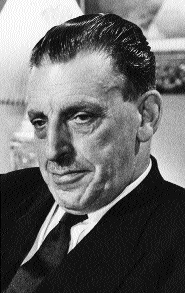
Taoiseach Seán Lemass-regarded the Pillar as an embarrassment.
His justification was that ‘it helps with the GPO to redeem O’Connell Street, potentially so beautiful, from a squalid disorder almost equal to parts of London’.
Few were influenced by such finely balanced notions. In 1954, the well regarded Association of the Old IRA, in effect middle-aged veterans of the War of Independence, demanded at a large meeting in the Mansion House that government introduce legislation which would have the Pillar removed. However the ‘move Nelson lobby’ no longer had support from the traffic planners. In 1954 and again in 1960 Dublin Corporation refused to recognise any good traffic reason for shifting Nelson’s Pillar. The Old IRA also found itself pitted against the Arts Council which issued a statement that the Pillar ‘had claims to be the finest Doric column in existence’. In one of many letters to the editor a wag taking that remark literally, asked ‘How, can one argue with a lump of granite with such a conceited view of itself?’.
In 1955, Dublin Corporation focused on Nelson himself, and proposed that the trustees of the Pillar be asked to agree merely to the removal of the Nelson statue. Stormont took notice and exchanges took place in the northern parliament (November 1955) about a possible Belfast site for the Dublin monument. Taoiseach John A. Costello, in his second term of office (1954-1957), also noted the growing trend of hostile opinion about the Pillar. On historical and artistic grounds he thought it should be left alone. He suggested to Radio Éireann that his friend and fellow graduate of King’s Inns, Dr. Thomas Bodkin, former director of the National Gallery (1927-1935), and director of the Barber Institute of Fine Arts, Birmingham, be invited to give a talk on the Pillar (December 1955). Bodkin’s notes were typed up in the Taoiseach’s office. He argued the architectural merits of the Pillar and scorned Nelson’s critics who ‘described [him] as a one-eyed monster or a one-armed adulterer…he was a man of extraordinary gallantry’. Bodkin instanced cities that retained monuments to individuals who had fallen from favour, including a fine monument to Tsar Peter the Great in Communist Leningrad. He was scathing of the suggestion that Nelson be replaced by a statue of the Blessed Virgin: ‘I can’t help thinking that she would not like to take charge of a column that was subscribed for and erected to the memory of someone else’.
‘Hold fast, Horatio!’
If Bodkin’s nationalist credentials might have been suspected by some, this was not the case with Desmond Ryan, one-time secretary to Patrick Pearse, and author of The Man called Pearse, who observed humorously:
We believe that Horatio Nelson’s Pillar is his castle; and he is a true Dublin citizen by squatter’s rights, by a century and a half’s public repentance for widely publicised human frailty, [and] by his unique contribution to the symmetry of the main street of our capital city.
(Irish Press 19 November 1955)
Ryan mentioned ‘the almost insoluble problem of any suitable tenant’ for the Pillar if it was vacated by Nelson. The contribution ended with—’Hold fast, Horatio!’.
Nonetheless, resentment against Nelson continued to grow. A frustrated Dublin City Council concluded in March 1956 that it was an intolerable absurdity to ‘have a public monument in private hands’. A resolution sought legislation ‘to enable the Dublin City Council to take possession of Nelson Pillar with power to remove or demolish the said Pillar in part or in whole as they see fit’. A Gaelic League statement (September 1956) made the point that having Nelson so prominently celebrated on the main street of the capital city was ‘virtually an insult’ (geall le masla) not merely to the Irish nation but to France’. Some felt that the new angle about French sensitivities was weakened by suggesting that Laurence O’Toole’s statue replace Nelson’s.
Sean Lemass became Taoiseach in 1959 and seems to have been the first to raise the Nelson issue at cabinet (12 November 1960). He suggested that Nelson be replaced by a statue of Saint Patrick in time for the Patrician Year, 1961. Two weeks later Lemass deferred discussion due to the absence of Dr Jim Ryan, Minister for Finance. and on 6 December 1960 the matter was again deferred because of the absence of Frank Aiken, Minister for External Affairs. Ryan and Aiken one may guess would have been ad idem with Lemass on the question of Lord Nelson.
A point of some concern was how much the Pillar’s trustees paid out to charity. One reference in the Taoiseach’s file suggested that £1,200 was involved, implying perhaps 50,000 visitors paying 6d each at the Pillar’s turnstiles. But it was later established that £400 per annum was the net sum which charities received. At any rate the idea died; the Attorney General was consulted about the status of the trustees, and it became apparent that a statue of Patrick was unlikely to be produced in time for the Patrician Year celebrations.
However the issue would not die down. Nelson continued to irritate people’s pride both at home and abroad. Michael Quill, a native of Cork and famous New York trade unionist, offered to finance the removal of Nelson from his perch and his replacement by someone else (John F. Kennedy was mentioned).
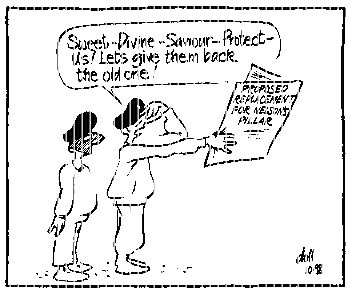
That offer, was not taken up but the constant flow of such stories caused real worry to the monument’s admirers. Lady Beatrice Glenavy RHA was moved to write an impassioned letter (11 January 1960) to the Irish Times: ‘the destructive genius of the Irish people seems to be at work again…In the name of all that has elegance, splendour, beauty and dignity, leave the Pillar alone’.
The matter was again raised at cabinet in July 1964, this time by Dr Jim Ryan. He proposed that a monument to Patrick Pearse be substituted for the Pillar in time for the fiftieth anniversary of the 1916 Rising. That afternoon, Lemass wrote a ‘Dear Jim’ letter to his Minister for Finance, mentioning (i) that legislation would be required (the trustees could not sell the Pillar to the state even if they wanted to), (ii) the traffic argument was no longer supported by the Corporation and traders in O’Connell Street might object to a change, (iii) it would be difficult to get a monument for Pearse ready for 1966. Wasn’t it taking twenty years (1945 until 1965) to get the Thomas Davis statue erected in College Green?. Ending the note, from one 1916 veteran to another, was the rather sad remark: ‘I agree we should look at the question, but I do not think it will be easy to reach the right answers’.
One summer’s day in 1965 a group of ‘young men’ took over the Pillar and locked out the public. They were said to be a splinter group of the IRA; they attempted to split or damage the Nelson statue by prolonged application of what were known as ‘heat throwers’ or ‘flame guns’ but Thomas Kirk’s thirteen foot high statute in Portland stone of Nelson leaning on a capstan, was too much for such trifling gadgetry.
It may have been the same group, smarting at the indignity of their earlier failure, who returned to the Pillar on the night of 2 March 1966, properly equipped this time with explosives and expertise. Like Nelson’s left arm, one hundred and sixty years earlier, his statue and the top of his column were blown away. Someone knows the truth about who planted and detonated the explosives which topped the Pillar on the morning of 3 March 1996. Joe Mac Criostail was one of those believed to have been involved, but his death was recorded in the last issue of History Ireland. No one is talking…
Micheál Ó Riain is a freelance writer.
Further reading:
P. Henchy, ‘Nelson’s Pillar’, in The Dublin Historical Record, vol 10 (1948-49).
M. Craig, Dublin 1660-1860 (Dublin 1952).
P. Somerville-Large, Dublin (London 1979).
D. Bennett, Encyclopaedia of Dublin (Dublin 1991).
















